All tea comes from the same bush—the Camellia Sinensis—which isn't so different than the familiar Camellia bushes we see in the states. They bloom with small white or pink flowers.

The main differences between teas — black, oolong, green and white—comes from the way the tea is processed. Subtle differences come from the climate, soil and growing practices.
Steps for each tea type:
White tea: Steps 1-3 and 6
Green tea: Steps 1-3, and 6
Oolong tea: Steps 1 through 6
Black tea: Steps 1 through 6
Step 1: Growing
Tea in China is planted in every conceivable place as you drive through the countryside. You see it in large flat fields planted in long rows. You see it in thinly sliced terraces up steep hillsides. And everywhere in between. Families plant bushes in their yards for personal use or to sell. Tea is literally everywhere.

On tea estates, you typically see it planted in long rows, with just enough room to walk between them. Bushes will typically be no higher than waist height of the tiny women who typically pick the tea.
Step 2: Plucking
Most premium teas are hand plucked. When the tea is ready, pluckers head out to the fields with baskets and carefully pluck the leaves, plucking on the leaves appropriate for the type of tea they are going to create. Sometimes it is just the very top leaf, called the bud, and sometimes it is the bud along with one or two leaves next to the bud. This is called "two leaves and a bud" which is the standard pluck.
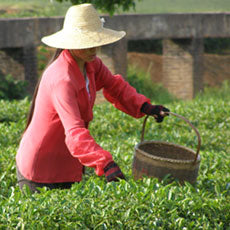
WATCH MOVIE CLIP
Some teas are machine plucked, such as lower grade teas that find their way into our ready-to-drink ice teas. But it is also used in quality Japanese style teas.
Step 3: Withering
All Teas are withered. Once the tea is plucked, it is brought into the tea processing plant where it is laid out evenly into large bins or trays to be withered. Withering is the process where the leaves start to essentially wilt, which softens the leaves and reduces some of the moisture, making them suitable and ready for rolling or other processing.
At this point, different teas go their different ways. White tea is simply dried. Green teas are fired or steamed and then dried. Black and Oolong teas are sent on to rolling.
WATCH MOVIE CLIP
Step 4: Rolling
(Oolong and Black Teas only) Rolling is the process of twisting the leaf to rupture the cell walls of the withered leaves. This opening allows the cell sap to spread like a film on the surface of the leaf and allows the leaf polyphenols and enzymes to mix with oxygen thereby beginning the process of turning the leaf from green to a coppery brown color.
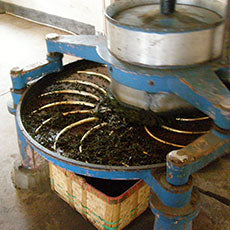
Step 5: Fermentation/Oxidation
(Oolong and Black Teas only) Rolled leaves are then put into racks or bins. Fermentation or, more accurately called oxidation, is the process where the rolled leaves are left to sit so that the tea sap and enzymes continue to interact with oxygen and continue to turn coppery brown.

Oxidation times differ, depending upon the type of tea being made. Oolongs range from less than 20% oxidized up to 80% oxidized. Black teas are typically completely oxidized, although Darjeelings are typically the least oxidized of the blacks. Oxidation can range anywhere from 30 minutes to 3 hours.
WATCH MOVIE CLIP
Step 6: Firing and Sorting
Green, Oolong, and Black teas are fired or steamed before final drying. Once the tea is processed, it is then fired (except White teas). Firing halts the oxidation process. The dried tea is then passed through vibrating screens of various mesh sizes to sort it into different grades. Final tea leaf size is a large factor in tea grading, which also helps determine its price and desirability. The larger sized tea pieces remain on top and are bagged, with the remaining falling through to be sorted separately.
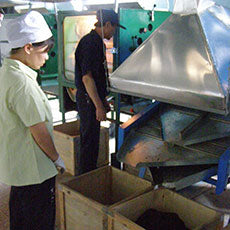
WATCH MOVIE CLIP
The Finished Tea
The final tea is graded and packed into crates for shipping. Grading is the process of judging size and style of leaf. Common terms include:
- Pekoe (rhymes with gecko). Comes from Pek Ho which, in Cantonese, refers to the white hairs of the new buds. Pekoe leaves are whole.
- Broken Orange Pekoe (BOP). Broken leaves with no tip (golden buds).
- Fannings. Smaller tea particles that drop down through the sorting sieve when grading.
- Dust: The smallest tea particles, most often used in tea bags.
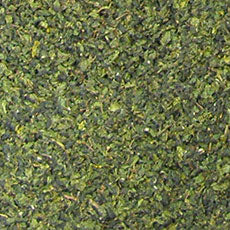
Selling Tea
Tea is sold in a variety of ways. China has a large number of retail tea shops as well as wholesale tea malls like the one to the left. This mall was over three stories tall, filled with shops that sold only tea or tea accessories such as teapots.
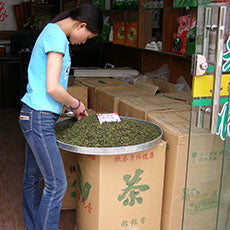
Tea estates also sell their tea directly to tea packers in China for domestic consumption as well as to importers and tea companies in the US and around the world.